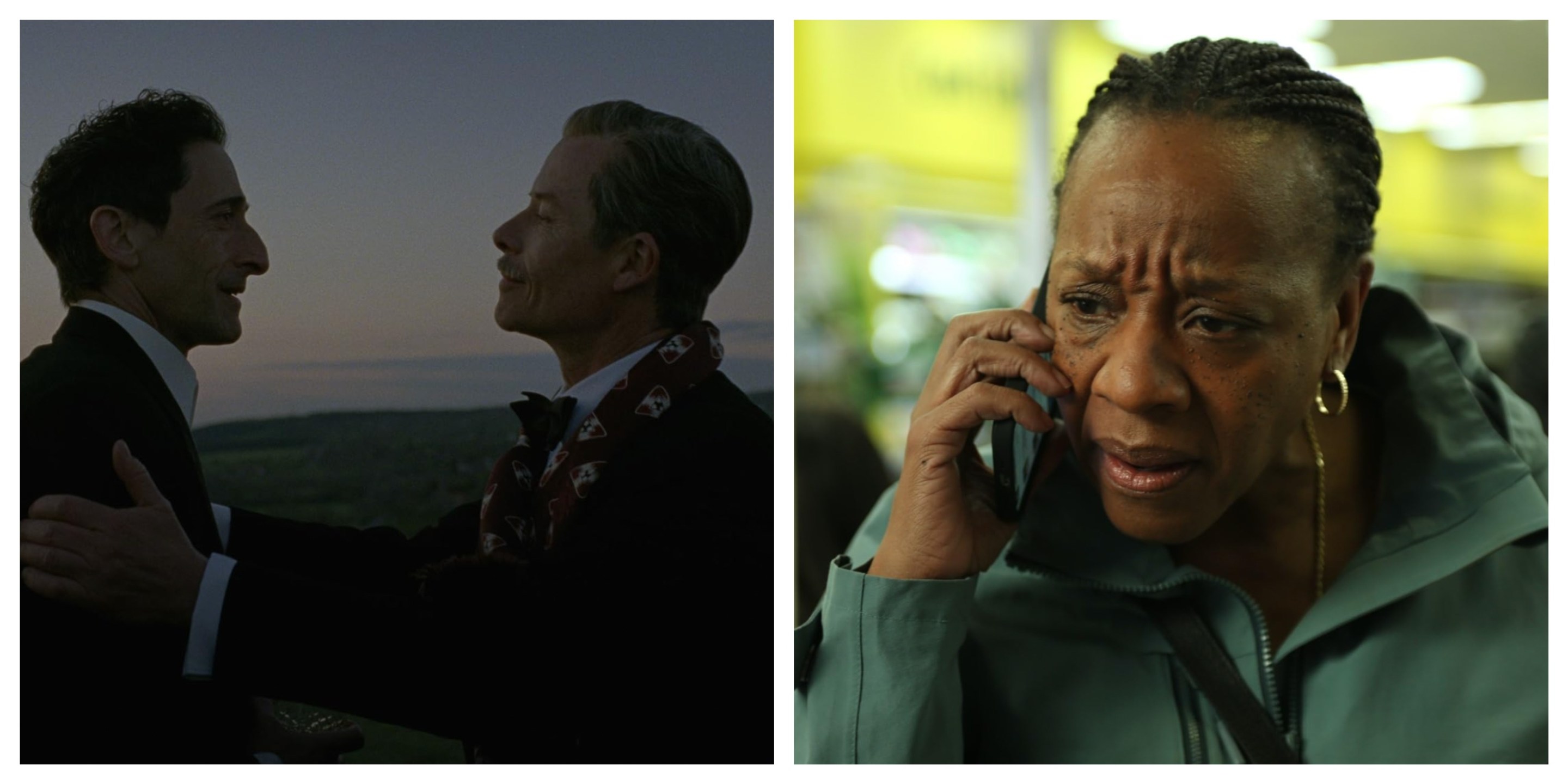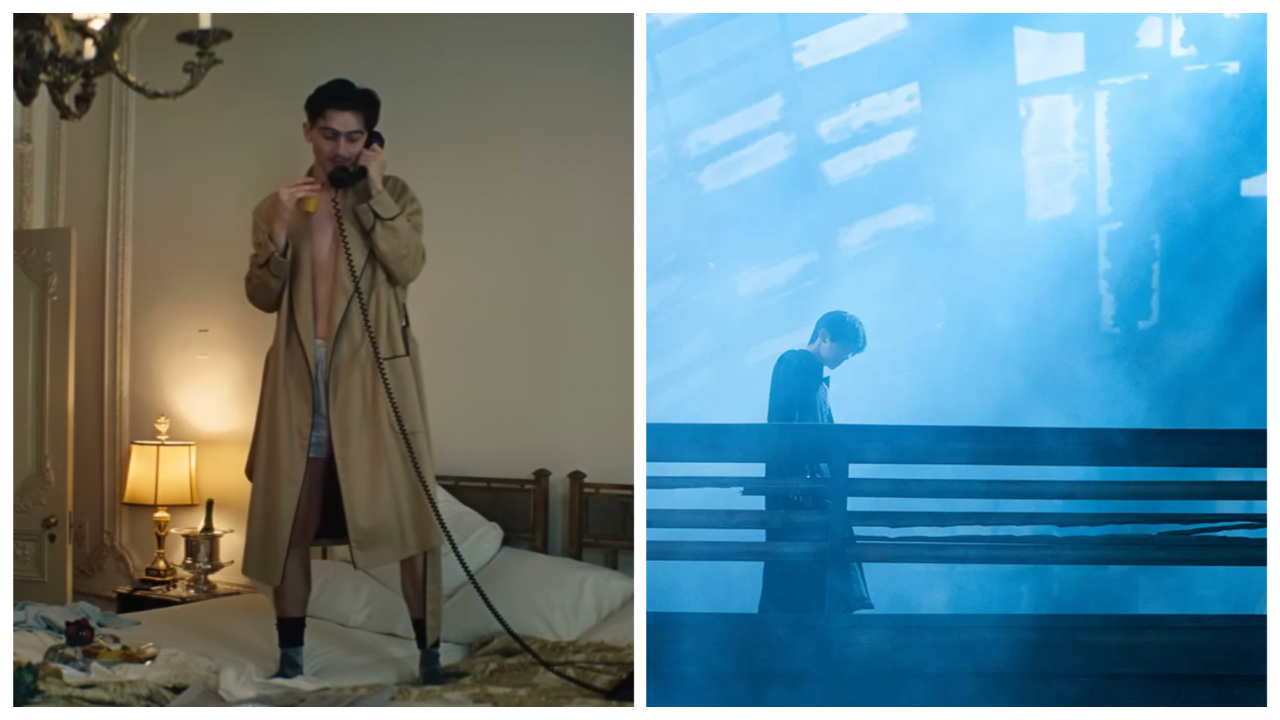A man struggles for his footing in the darkness, jostling against barely discernible others, bodies fumbling forward in desperation or anticipation. In a brief scene before this, we’d watched a young woman silently undergo questioning, and maybe we tense up now at the sight of these massed humans, expecting the worst. Finally, some light: We’re in the hold of a ship, and it’s arrived in New York. There’s the Statue of Liberty, upside down, as seen from the vantage point of László Tóth (Adrien Brody, once more a heroic European Jew) a Bauhaus-tutored architect and Buchenwald survivor.
This is how The Brutalist begins, within almost embryonic shadow and clamor, and Brady Corbet’s aspiring epic again plunges into darkness for its conclusion, now entering a tomb rather than emerging from a womb. A manhunt races through the unfinished construction site of the enormous community center that Tóth had been hired to design in Pennsylvania. It’s a maze of unlit horror and echoed shouts, and what we see upside down is a cross, cut in the roof of the center, another misleading beacon to those scurrying around below.
These are the tremendous moments, in which not-so-subtle images communicate boldly what language cannot, the sort only a filmmaker gifted with a certain degree of self-importance can achieve. Corbet delivers such broad strokes with the kind of confidence that gets you halfway to success. When we reach the 15-minute pee break at its dead center, 100 minutes down and another 100 to go, The Brutalist has far from worn out its welcome. But it hasn’t quite shown its hand either. We still feel like anything can happen.
Unfortunately, it does. The conventional wisdom among those who correctly do not consider The Brutalist a masterpiece is that it falls apart in this second half, but that’s being too generous. What really happens is that Corbet’s film loses the shape of a masterpiece; the sturdy facsimile of a great film we were watching reveals itself as something lumpier and less monumental, as its story can’t help but redefine what we saw earlier. (Look at how good I’m being—not a single comment about this architect’s tale failing to “build” on its “foundation.”)
The Brutalist tracks the disillusionment of a man who believed himself beyond illusion. Finding only bread lines and isolation in New York, Tóth heads down to Philadelphia, where his aggressively assimilated cousin Attila (a slick Alessandro Nivola) runs a furniture shop called Miller and Sons. (“There’s no Miller and there are no sons,” László observes.) Atilla's shiksa wife (Emma Laird) is repelled by László’s lingering foreignness and, when he doesn’t shove off fast enough, says he made a pass at her.
Tóth turns to shovelling coal, and scenes of his prole existence are intercut with clips of films touting the economic potential of the great commonwealth of Pennsylvania. (Irony!) Just as he seems resigned to a life of drudgery, Guy Pearce strides into the film as Harrison Van Buren, a confident inhabitant of the American Century with the bank account of a war profiteer to back himself up. A Bucks County nouveaux with a pseud’s hunger for as much expert-approved culture that money can buy, Van Buren is intrigued by Tóth’s CV.
After Van Buren’s son Harry (Joe Alwyn, who wisely seems to have made spoiled scumbags his speciality) brings Tóth into his orbit, the industrialist springs an idea on Tóth: The Van Buren Institute, a massive community center (complete with library, theatre, gym, and chapel) for the suburban backwater of Doylestown, dedicated to his late, beloved mother. With full creative control, of course. (At least until it goes overbudget.)
Work begins, and Tóth’s wife Erzsébet (Felicity Jones) finally arrives in America. She’s accompanied by his teen niece Zsófia (Raffey Cassidy) left mute by Dachau, who creeps out Van Buren’s guests and titillates his creepy son. The Tóth’s reunion does not go smoothly—Jones struggles against the script to make Erzsébet a character, rather than a provider of counterpoint to László—and neither does the construction of the Institute. When Erzsébet literally grapples with her husband’s sexual dysfunction, (when did the aggro handjob become the 21st century screen representation of female dominance?), you don’t need to be a Freudian to recognize that sometimes a high-ceilinged concrete monument isn’t just a… ah, you know the rest.
Throughout, Brody and Pearce both suggest unspoken depths in their characters, less as rivals then as complementary models of ambition. But their relationship is static: The two men rub against each other like sticks, failing to catch a spark. So Corbet douses them in gasoline and fires up a blowtorch. Something dramatic has to happen, and when that grotesque moment arrives, it clumsily literalizes the metaphorical. By reducing László to a representation of all that he loathes, Van Buren dehumanizes himself as well. But for me these two living abstractions of identity, however richly performed, struck me as barely human to begin with, and rather than crystalizing their relationship, the film’s turning point reinforced the distance I felt.
Though many big-name influences dot reviews forThe Brutalist, when it comes to filmmaking heroics, Paul Thomas Anderson is Corbet’s direct predecessor. But while Anderson’s epics consciously play against the stodginess of the genre, Corbet is drawn to the monumental. He wants to tame an absurd modernity with Old World verities. That’s a shame, because Corbet lacks the truly cruel edge of a Bertolucci or a Visconti; cut off from the American spirit of vulgarity that turns a film into a movie, Corbet’s received European sympathies hobble him.
The Brutalist is a film about grandiosity that also aspires to it, and the script, written by Corbet and his partner, filmmaker Mona Fastvold, lays out the story in slabs of concrete. (A tale of Holocaust survivors complete with heroin addiction and sexual assault? Now that’s cinema.) Corbet and his regular cinematographer Lol Crawley shot The Brutalist in VistaVision, a high-res 1950s format introduced to compete with the convenience (but low quality image) of TV. But if Hitchcock embraced VistaVision as a technological advance, Corbet’s use is a gesture of fealty to a bygone age.
The Brutalist contains some striking images of Hungary standing in for eastern Pennsylvania, but too many moments are dimly lit when they don’t need to be, in keeping with current cinematic preferences. And Corbet doesn’t earn his little visual reference from The Seventh Seal at all.
If I’m complaining a lot about a movie I generally enjoyed, that’s because its admirers, while acknowledging its flaws, don’t seem to mind them. Critics and viewers alike seem overly eager to meet Corbet halfway—the paradox of filmmaking ambition is that rather than raising the bar of comparison, we admire the lunge of the batter as he swings wildly at a pitch outside the strike zone.
For a film supposedly about ideas, The Brutalist is strangely devoid of them, unless you count “rich people will fuck you over,” “Americans hate foreigners,” and “the Holocaust!” Tóth makes some vague comments about “beauty,” but he’s reticent about articulating his aesthetic, aside from one brief speech about the permanence of architecture that mostly just tells us that Corbet digs Andrei Rublev. Then again, don’t all champions of the mistreated artist?
When a “told ya so” of an epilogue finally spells out Tóth’s aesthetic with all the subtlety of a museum placard, that makes the film’s skirting of ideas all the more glaring. At last, we’re told he believed “it is the destination, not the journey, that matters”—a strange way to conclude a film that never quite gets where it’s going.
When someone casually proposes a little family get-together in a Mike Leigh film, it inevitably turns out far from casual. As surely as one of Leigh’s working class Londoners will dismissively drawl “dawwnt be styupid” in the course of this movie, you know some shit’s going down at that party.
You can trace Leigh’s brilliance at exploiting the theatrical potential of a small gathering at least back to his 1977 satire of British middle-class aspirants, Abigail's Party. In 2004’s Vera Drake, a matronly ’50s abortionist was arrested during an intimate Christmas party. And it was at a family cookout in 1996’s Secrets & Lies that Leigh regular Timothy Spall ate a bunless sausage with his bare hands as a very white Brenda Blethyn informed her relatives that her Black “friend” Horentse (Marianne Jean-Baptiste) was in fact the daughter she’d given up for adoption years earlier.
Jean-Baptiste is reunited with Leigh for Hard Truths, and once more all eyes will be on her at the film’s party centerpiece. But Pansy Deacon is far from the unassuming optometrist Hortense Cumberbatch. She’s a right nightmare, to put it bluntly, and Pansy always puts it bluntly. When her sister Chantelle (Michele Austin) proposes that Pansy swing by the house after they visit her mother’s grave together for Mother’s Day, Pansy irascibly refuses to commit.
By this point in Hard Truths, we expect nothing less from Pansy. We’ve seen her dour husband Curtley (David Webber) and heavyset adult son Moses (Tuwaine Barrett) sit in cowed silence like hostages at the dinner table as she rants about grinning charity workers who demand your address, dogs dressed up in “green booties,” and babies wearing outfits with pockets. “What’s it gonna keep in its pockets? A knife?” she demands.
Though Leigh is sometimes called a realist, the characterizations he coaxes from his actors are broader than that term suggests. You could call their exaggerated natures Dickensian, but they have as much in common with Ben Jonson’s Jacobean comedy of humors, in which characters suffer from an imbalance of certain bodily fluids, which causes one aspect of their personalities to dominate to the detriment of the others. “Choleric” is how Renaissance quacks would have diagnosed our Pansy, a victim of a surfeit of yellow bile.
While Leigh’s dramas aren’t dependent on antiquated science, something is out of whack with his maladepts, and they know it. As with David Thewlis in Naked spewing sardonic critiques of the modern world or the infuriatingly chipper Sally Hawkins in Happy-Go-Lucky, Pansy’s extreme personality is a time-honed defense mechanism over which she’s lost control. “Why are you so angry? Why can’t you enjoy life?” Chantelle asks Pansy flat out, and in a moment of naked candor her sister replies, “I don’t know.”
To those of us who don’t have to share the screen with her, Pansy is caustically hilarious. When she rails at supermarket cashiers, furniture salespeople, doctors, dental hygienists, and whoever else is unfortunate enough to find themselves within her orbit, her vituperative eloquence would be the envy of any insult comic.
Yet Pansy lives in a world of constant danger. She habitually wakes up screaming, as though she’d been visited in the night by three ghosts who warned her to mend her ways, and she’d told them all to piss off. The home she’s always cleaning looks practically unlived in, and it’s free of plants (they carry insects). She reacts to a fox in the backyard as though a rat had scurried past her feet and she sleeps with the sprawled determination known only to the truly depressed. When Moses takes long, pointless walks to escape her, she shrieks, “They’ll pick you up for loitering with intent!” at him; his ever-present headphones block her out.
In contrast, Chantelle is a hairdresser with an easy, empathetic way with clients who jokes freely with her adult, professional daughters Kayla and Aleisha (Ani Nelson, Sophia Brown). And because everyone lives a full life outside the main storyline in Leigh’s films, we see each character at work (except Pansy and Moses), dealing with bosses both kindly and condescending or, in Curtley’s case, removing a hefty tub from an old flat.
Surely some of the internet’s anal cinema-efficiency experts are already seething on YouTube: “These scenes don’t advance the plot!” And Leigh’s manner of offering glimpses of people’s stories may be a tough sell to a generation of viewers who insist on seeing the submerged bits of the iceberg as well—because it didn’t wrap up neatly, one complainer on Letterboxd said Hard Truths felt like the first episode of a series.
We don’t get a simple answer as to how Pansy and Chantelle turned out so differently, though we do learn that they lived very different childhoods within the same house. In a worse movie, a child or a dog would soften Pansy up, and she’d deliver an Oscar-primed speech about her formative trauma. Instead, an act of kindness draws a complicated response (and better acting than whoever will win that dumb trophy) from Pansy, and eventually the long standoff between her and Curtley enters a new stage.
Hard Truths is Leigh’s first film set in the present since Another Year in 2010, though he’s made two period pieces since then. Curiously, because of how Leigh works on his smaller films—14 weeks of improvisatory prep as he and the actors devise the story together, followed by a strictly chronological shoot—he has an easier time securing a budget for an epic like Peterloo (where he can tell producers what’ll happen) than he does for a small-scale production like Hard Truths, where plot is left to chance.
Hard Truths is also a return to the modest London milieu where Leigh set his brilliant streak of films in the ’90s. Leigh’s repeated small-scale reworkings of everyday life may make him the closest the English-speaking film world has to Ozu; his theater background and commitment to a stable of actors also suggest a more chipper Bergman. Not that Leigh needs these comparisons—his films are their own species.
Or at least he shouldn’t need such comparisons. Locally, Hard Truths is holed up in tiny Theater 14 of the Southdale AMC, across the way from the magisterial IMAX theater where The Brutalist screens. As with many traditional arthouse releases that once would have beelined to a Landmark theater (I saw Mr. Turner at the Uptown ten years ago), it’s likely to languish at the mall, underseen for weeks, showing at odd afternoon hours.
The Oscars are as likely to overlook the brilliant performances here (Jean-Baptiste, of course, but Austin as well) just as the Golden Globes did. Though Hard Truths received the usual critical acclaim, it doesn’t arrive with an A24 imprimatur and attendant air of significance. You don’t “need to see it on the big screen” (though it rings out with immediacy if you do) and it’s not a talker—it doesn’t require thinkpieces to explicate its cultural import. In fact, when critics suggested that it’s a “post-pandemic” film, Leigh, ever the ineffective salesman, denied that he’d intended anything so relevant.
As Leigh turns 82 in a month, and the death of his longtime cinematographer Dick Pope after shooting Hard Truths reminds us nothing is forever, I wish I could think of some contemporary filmmakers I’d compare to him. Mike Leigh doesn’t set out to make monumental films—he simply makes excellent ones.
GRADES
The Brutalist — B
Hard Truths — A
The Brutalist and Hard Truths are now showing in area theaters.






